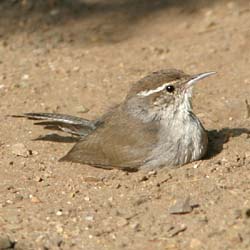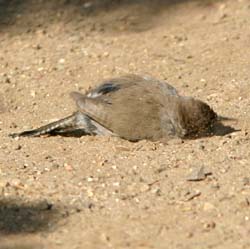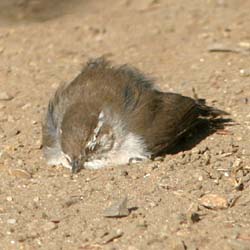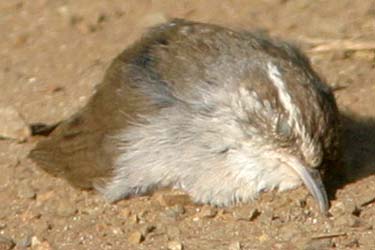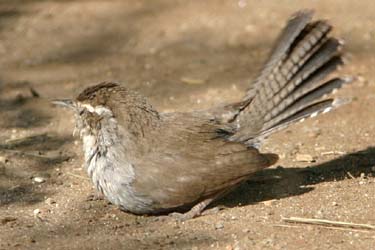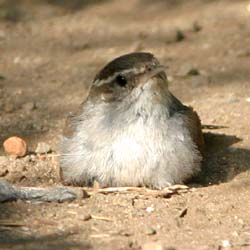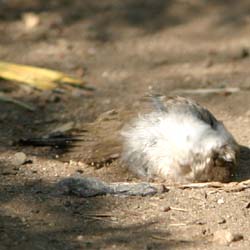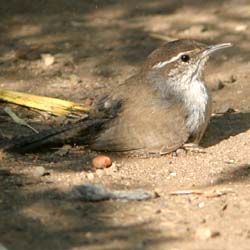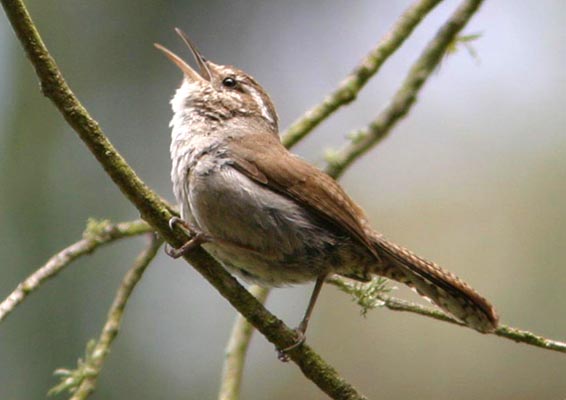 Bewick's
Wren is a common resident of brushy habitats, riparian undergrowth, and
chaparral throughout MTY. It is one of those wrens with "personality:"
inquisitive, vocal, active, and aggressive. Its loud song is a common background
sound when birding this county (the male right was singing loudly
from a branch 20' off the ground inside the eucalyptus grove at Moonglow
Dairy). This wren has a wide variety of vocalizations. I often tell people
that when they hear an unfamiliar bird call in wooded country in MTY, odds
are it is either an Oak Titmouse or a Bewick's Wren. Bewick's
Wren is a common resident of brushy habitats, riparian undergrowth, and
chaparral throughout MTY. It is one of those wrens with "personality:"
inquisitive, vocal, active, and aggressive. Its loud song is a common background
sound when birding this county (the male right was singing loudly
from a branch 20' off the ground inside the eucalyptus grove at Moonglow
Dairy). This wren has a wide variety of vocalizations. I often tell people
that when they hear an unfamiliar bird call in wooded country in MTY, odds
are it is either an Oak Titmouse or a Bewick's Wren.
This singing bird at Moonglow Dairy is smack dab in the intergrade zone
between "Vigor's Bewick Wren" T.b. spilurus, occurring from Santa
Cruz north, and "San Diego Bewick Wren" T.b. correctus from the
Salinas Valley south [Alan Phillips considered correctus to be a
synonym of charienturus]. It is a mouse-colored wren with a browner
back and tail; the northern spilurus race is slightly darker and
shorter-tailed than southern birds. At all ages and at all seasons, the
prominent white supercilium is a standard field mark.
During our Breeding Bird Atlas project, atlasers estimated the local
MTY population at 20,000 pairs. It occurs at all altitudes and everywhere
that has a brushy understory, but can be rare or absent in climax Monterey
Pine forests on the Peninsula (except where there is sunlight and chaparral).
Nesting occurs primarily in April and May, but some females apparently
attempt to raise two broods (or else June nests are replacements of prior
attempts that failed). Our local birds appear to maintain and defend territories
year-round. However, in winter, we get additional birds from populations
to the north or east, so some populations elsewhere are decidedly migratory. |
 Bewick's
Wren is a common resident of brushy habitats, riparian undergrowth, and
chaparral throughout MTY. It is one of those wrens with "personality:"
inquisitive, vocal, active, and aggressive. Its loud song is a common background
sound when birding this county (the male right was singing loudly
from a branch 20' off the ground inside the eucalyptus grove at Moonglow
Dairy). This wren has a wide variety of vocalizations. I often tell people
that when they hear an unfamiliar bird call in wooded country in MTY, odds
are it is either an Oak Titmouse or a Bewick's Wren.
Bewick's
Wren is a common resident of brushy habitats, riparian undergrowth, and
chaparral throughout MTY. It is one of those wrens with "personality:"
inquisitive, vocal, active, and aggressive. Its loud song is a common background
sound when birding this county (the male right was singing loudly
from a branch 20' off the ground inside the eucalyptus grove at Moonglow
Dairy). This wren has a wide variety of vocalizations. I often tell people
that when they hear an unfamiliar bird call in wooded country in MTY, odds
are it is either an Oak Titmouse or a Bewick's Wren.
